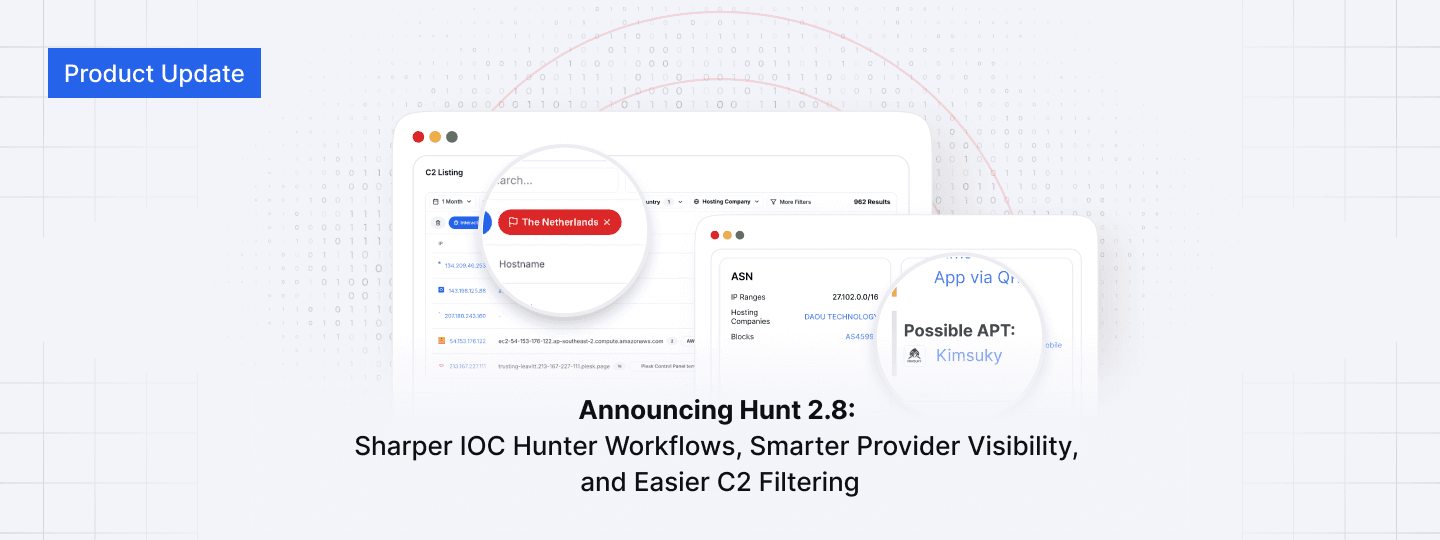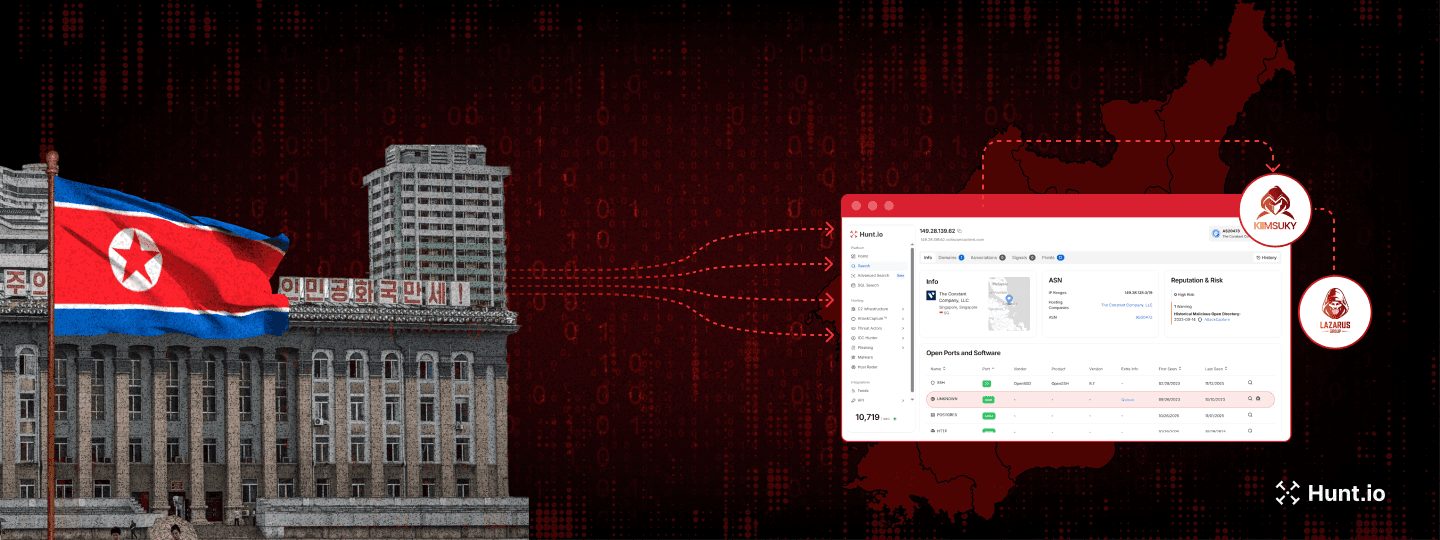The Accidental Malware Repository: Hunting & Collecting Malware Via Open Directories (Part 1)
Published on
Published on
Published on
Feb 1, 2024
Feb 1, 2024
Feb 1, 2024




The Accidental Malware Repository: Hunting & Collecting Malware Via Open Directories (Part 1)
This post will serve as the first in a long series of articles on using the platform to identify malicious infrastructure and hunt across the open internet for malware, phishing pages, and whatever else may pose harm to the networks we defend.
For our initial blog in this hunting workshop, we'll leave our territory and peruse an open directory containing a phishing site, which also happens to be hosting the XWorm RAT.
Did You Know?
You can find open directories across a network of over 5,000 sources, enabling you to quickly pinpoint specific file names, sandbox results for hosted malware samples, exposed shell history, and more with a single click. If you haven't already, apply for an account and give the Hunt platform a try.
-img_1_3x.webp) Figure 1: Hunt Open Directory Feature
Figure 1: Hunt Open Directory FeatureOne of our budding researchers discovered the IP address 65.1.224[.]214:80 while collecting intelligence on servers hosting malicious software. Digging deeper into the open directory, we see some interestingly named files, including a sub-directory titled "/We."
-img_2_3x.webp) Figure 2: Suspect Open Dir
Figure 2: Suspect Open Dir*You can download and obtain a file hash or see what other servers host the same file by clicking one of the buttons under "Actions."
For the eagle-eyed reader, you may have noticed that Hunt detects the lazily named "PowerShell.ps1" as the XWorm RAT. We'll take a look at that file, as well as the others, later. For now, let's check out the /We directory.
-img_3_3x.webp) Figure 3: File contents of the /We directory
Figure 3: File contents of the /We directoryThe folder contains several files, including images, an image folder, and HTML & PHP pages. Files titled "BlockChain_Login" and "Device_Verification" lead us to believe that whoever is controlling this server is attempting to phish user credentials, posing as the legitimate site, likely for the theft of digital currency.
Let's take a look at the malicious login page.
-img_4_3x.webp) Figure 4: Spoofed Login Page
Figure 4: Spoofed Login Page-img_5_3x.webp) Figure 5: Legitimate Login Page
Figure 5: Legitimate Login PageIf you've investigated phishing pages before, the malicious login page is often a carbon copy of the legitimate site, with limited functionality outside of capturing credentials on login.
If we refer back to the /We folder, there are files for the "Import Your Account" button. Clicking on the button reveals an additional attempt to steal the user's recovery phrase.
-img_6_3x.webp) Figure 6: Attempt To Steal Private Key Phrase
Figure 6: Attempt To Steal Private Key PhraseSo far, some web pages are attempting to spoof a digital currency financial services company. Interesting and worth reporting (hopefully, your users aren't trading currency on the company network), but the multiple .bat, .vbs, and .ps1 files may really pique your interest.
-img_7_3x.webp) Figure 7: Batch File Which Initiates Execution
Figure 7: Batch File Which Initiates ExecutionWhile a thorough analysis of the files themselves is outside the scope of this post, Downloader.bat, void of any obfuscation, downloads the PowerShell script we saw earlier.
-img_8_3x.webp) Figure 8: PowerShell Script To Download .bat & .vbs files
Figure 8: PowerShell Script To Download .bat & .vbs filesThe script, thoughtfully written with comments, downloads two files and checks if the documents already exist on the victim machine; if not, it executes the VBS file from a hidden window.
-img_9_3x.webp) Figure 9: Malicious VBS File
Figure 9: Malicious VBS FileAgain, the visual basic file checks if the 2.bat file is on the victim host and, if so, runs the file silently.
-img_10_3x.webp) Figure 10: Encoded Batch File
Figure 10: Encoded Batch File2.bat, when executed, drops a file named 2.bat.exe in the %TEMP% folder. Luckily, the decryption key can be found within the code, and decompression is trivial.
-img_11_3x.webp) Figure 11: Decompressed & Decrypted Code
Figure 11: Decompressed & Decrypted CodeWhat Else Can I Find?
Short answer: just about anything you can think of. We constantly scan and update our database of open directories and their associated files, ensuring the most up-to-date information for defenders and researchers looking to analyze malicious samples and thwart actors attempting to damage their reputations.
As we progress in this series, we'll dive deeper into how Hunt can assist in hunting for the next significant threat, keeping our networks and brands safer one blog at a time.
Found something interesting using the Open Directories feature, please share it on X (Twitter), LinkedIn, or Mastodon.
This post will serve as the first in a long series of articles on using the platform to identify malicious infrastructure and hunt across the open internet for malware, phishing pages, and whatever else may pose harm to the networks we defend.
For our initial blog in this hunting workshop, we'll leave our territory and peruse an open directory containing a phishing site, which also happens to be hosting the XWorm RAT.
Did You Know?
You can find open directories across a network of over 5,000 sources, enabling you to quickly pinpoint specific file names, sandbox results for hosted malware samples, exposed shell history, and more with a single click. If you haven't already, apply for an account and give the Hunt platform a try.
-img_1_3x.webp) Figure 1: Hunt Open Directory Feature
Figure 1: Hunt Open Directory FeatureOne of our budding researchers discovered the IP address 65.1.224[.]214:80 while collecting intelligence on servers hosting malicious software. Digging deeper into the open directory, we see some interestingly named files, including a sub-directory titled "/We."
-img_2_3x.webp) Figure 2: Suspect Open Dir
Figure 2: Suspect Open Dir*You can download and obtain a file hash or see what other servers host the same file by clicking one of the buttons under "Actions."
For the eagle-eyed reader, you may have noticed that Hunt detects the lazily named "PowerShell.ps1" as the XWorm RAT. We'll take a look at that file, as well as the others, later. For now, let's check out the /We directory.
-img_3_3x.webp) Figure 3: File contents of the /We directory
Figure 3: File contents of the /We directoryThe folder contains several files, including images, an image folder, and HTML & PHP pages. Files titled "BlockChain_Login" and "Device_Verification" lead us to believe that whoever is controlling this server is attempting to phish user credentials, posing as the legitimate site, likely for the theft of digital currency.
Let's take a look at the malicious login page.
-img_4_3x.webp) Figure 4: Spoofed Login Page
Figure 4: Spoofed Login Page-img_5_3x.webp) Figure 5: Legitimate Login Page
Figure 5: Legitimate Login PageIf you've investigated phishing pages before, the malicious login page is often a carbon copy of the legitimate site, with limited functionality outside of capturing credentials on login.
If we refer back to the /We folder, there are files for the "Import Your Account" button. Clicking on the button reveals an additional attempt to steal the user's recovery phrase.
-img_6_3x.webp) Figure 6: Attempt To Steal Private Key Phrase
Figure 6: Attempt To Steal Private Key PhraseSo far, some web pages are attempting to spoof a digital currency financial services company. Interesting and worth reporting (hopefully, your users aren't trading currency on the company network), but the multiple .bat, .vbs, and .ps1 files may really pique your interest.
-img_7_3x.webp) Figure 7: Batch File Which Initiates Execution
Figure 7: Batch File Which Initiates ExecutionWhile a thorough analysis of the files themselves is outside the scope of this post, Downloader.bat, void of any obfuscation, downloads the PowerShell script we saw earlier.
-img_8_3x.webp) Figure 8: PowerShell Script To Download .bat & .vbs files
Figure 8: PowerShell Script To Download .bat & .vbs filesThe script, thoughtfully written with comments, downloads two files and checks if the documents already exist on the victim machine; if not, it executes the VBS file from a hidden window.
-img_9_3x.webp) Figure 9: Malicious VBS File
Figure 9: Malicious VBS FileAgain, the visual basic file checks if the 2.bat file is on the victim host and, if so, runs the file silently.
-img_10_3x.webp) Figure 10: Encoded Batch File
Figure 10: Encoded Batch File2.bat, when executed, drops a file named 2.bat.exe in the %TEMP% folder. Luckily, the decryption key can be found within the code, and decompression is trivial.
-img_11_3x.webp) Figure 11: Decompressed & Decrypted Code
Figure 11: Decompressed & Decrypted CodeWhat Else Can I Find?
Short answer: just about anything you can think of. We constantly scan and update our database of open directories and their associated files, ensuring the most up-to-date information for defenders and researchers looking to analyze malicious samples and thwart actors attempting to damage their reputations.
As we progress in this series, we'll dive deeper into how Hunt can assist in hunting for the next significant threat, keeping our networks and brands safer one blog at a time.
Found something interesting using the Open Directories feature, please share it on X (Twitter), LinkedIn, or Mastodon.
Related Posts:
Get biweekly intelligence to hunt adversaries before they strike.
Latest News
Hunt Intelligence, Inc.
Get biweekly intelligence to hunt adversaries before they strike.
Latest News
Hunt Intelligence, Inc.
Get biweekly intelligence to hunt adversaries before they strike.
Latest News
Hunt Intelligence, Inc.








